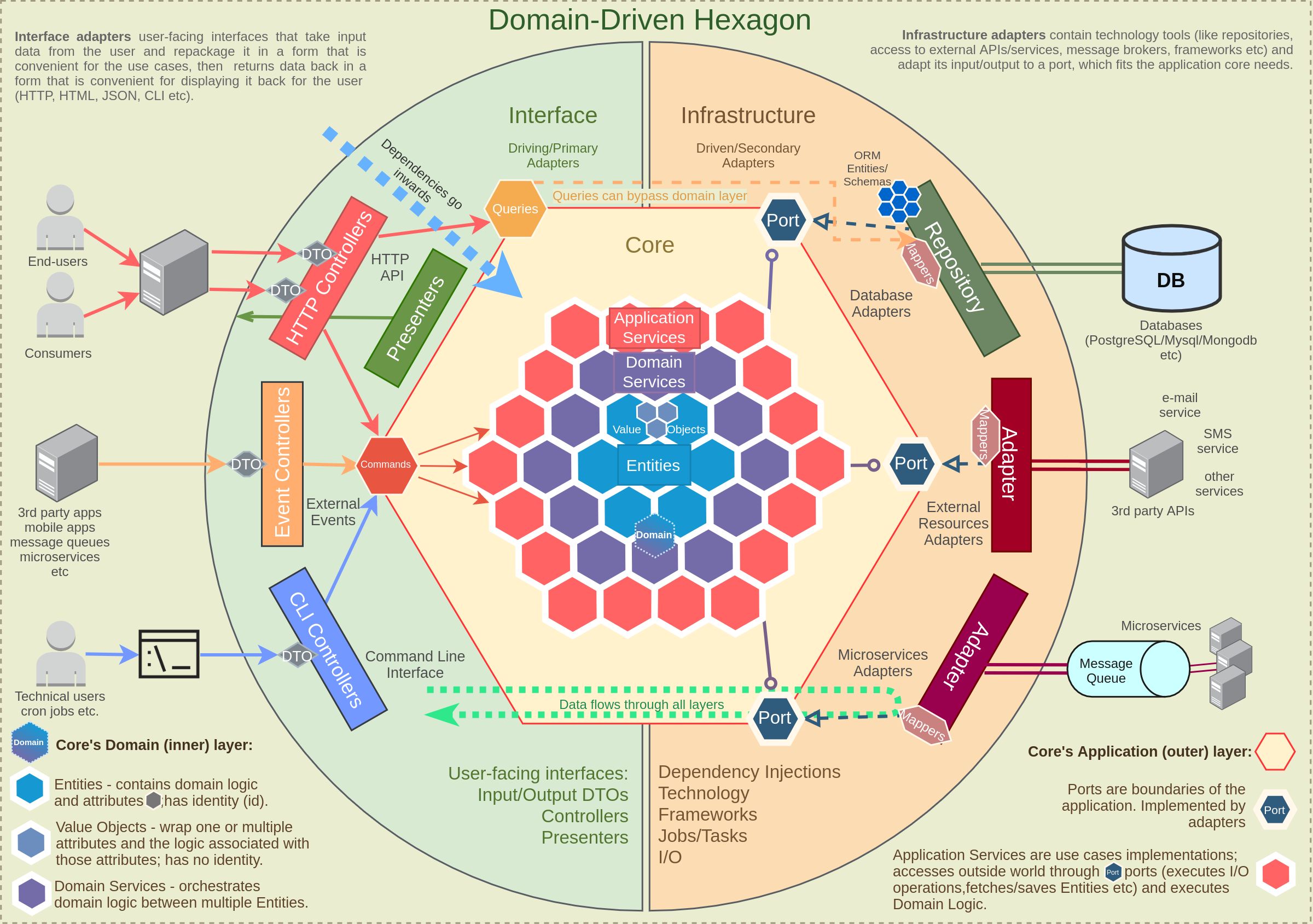# Architecture
# Introduction
The architecture of this application is inspired by the Domain Driven Hexagon (opens new window). You will find some similarities but not all the Domain Driven Hexagon is implemented, it's an adaptation to meet our needs.

# Modules
This project's code examples use separation by modules (also called components). Each module gets its own folder with a dedicated codebase, and each use case inside that module gets it's own folder to store most of the things it needs (this is also called Vertical Slicing).
It is easier to work on things that change together if those things are gathered relatively close to each other. Try not to create dependencies between modules or use cases, move shared logic into a separate files and make both depend on that instead of depending on each other.
Try to make every module independent and keep interactions between modules minimal. Think of each module as a mini application bounded by a single context. Try to avoid direct imports between modules (like importing a service from other domain) since this creates tight coupling. Communication between modules can be done using events, public interfaces or through a port/adapter.
# Use cases
- Typically used to orchestrate how the outside world interacts with your application and performs tasks required by the end users / services.
- Should not depend on other application services since it may cause problems (like cyclic dependencies);
What are "Use cases"?
Wikipedia says:
In software and systems engineering, a use case is a list of actions or event steps typically defining the interactions between a role (known in the Unified Modeling Language as an actor) and a system to achieve a goal.
# Business
Business is also called Domain Services is the DDD world.
Eric Evans, Domain-Driven Design:
Domain services are used for "a significant process or transformation in the domain that is not a natural responsibility of an ENTITY or VALUE OBJECT"
- Domain Service is a specific type of domain layer class that is used to execute domain logic that relies on two or more
Entities. - Domain Services are used when putting the logic on a particular
Entitywould break encapsulation and require the Entity to know about things it really shouldn't be concerned with. - Domain services operate only on types belonging to the Domain.
# Forbidden: django fat models
You can find a lof of information on the internet about django fat models and more generally about fat models. If you don't know about fat models, this is good because it is forbidden in this project. If you do, don't create fat models otherwise your PR will be declined, I will ask to refactor even if you did a fantastic job.
In summary, Fat models make you write most (if not all) of your business logic/rules into your Django Models.
# Why is it forbidden?
At the very beginning of this project we used fat models for the sake of simplicity. Then the project growth and it was becomming a mess. After a bit of research and analyze, I decided to refactor my fat models to use the architecture described above.
Here is a non-exhaustive list of why:
- fat models are hard to test. It requires a lot of mocking.
- create unnecessary coupling. You will end-up with your models beeing linked with each other for no reason and they will be coupled to business functions, like sending emails, calling celery tasks...
- separation of concerns: my business logic do not belogs to my data layer. Violation of the Single Responsability Principle (SRP).
- concrete example: my model
AlarmStatuswas sending mqtt messages to turn on the alarm, and does a bunch of things (create jobs to verify the alarm actually turned on/off...). The responsibility of a model is to handle the data, not to do all these stuffs.
- concrete example: my model
- unexpected behaviors if things are done inside the
save(or similar) method.- concrete example: if a motion is being detected I don't want to turn off the service alarm (don't send mqtt message). But I still want to have the possibility to force it, if I forgot to turn off the alarm and it is me, I want to turn off the alarm. If you implement this use case inside the
savemethod it will be hard and hacky becauseforcestatus is not related to the model.
- concrete example: if a motion is being detected I don't want to turn off the service alarm (don't send mqtt message). But I still want to have the possibility to force it, if I forgot to turn off the alarm and it is me, I want to turn off the alarm. If you implement this use case inside the
- More things...
← Upgrade Automations →